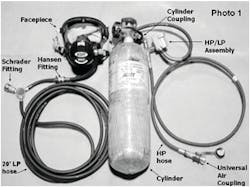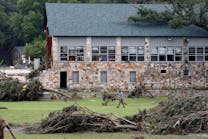"Mayday, Mayday, Mayday". Ladder One Officer to Command, Mayday"
"Command to Ladder One Officer, go ahead with your Mayday"
"Ladder One to Command, Mayday, I am lost in the basement and running out of air, I am not sure where I am!"
"10-4. Command to the Rapid Intervention Team, I have a lost member in the basement and he is running out of air, go get him!"
"RIT to Command, 10-4"
"RIT to Ladder One, activate your PASS alarm, we're coming to get you"
Yep, another on of those scenarios that a commanding officer does not want to hear. But, if it happens, are you ready? I am fairly sure that most of the departments in the U. S. have some kind of RIT in place if a member goes down or gets lost. But do you have a plan of action if the member is out of air or is trapped and in an immediately dangerous to life and health (IDLH) and the extrication will take some time? This is where the RIT PAK will come in handy.
When I am conducting a live burn exercise, or for that matter any evolution that that I feel a RIT would be beneficial, first I ask for volunteers. Usually the attendees will all take a step back. Of course I will then appoint a boss and have him pick members to fill the positions and we will have a talk about the importance of the RIT. No one wants to "miss" a working fire, standing outside, watching everyone else go in and "do the job". But if something were to happen to a member inside of the building, there is no more important of a job than the RIT, except maybe the nozzle team, because if they abandon their position, the whole operation might go to "hell in a hand basket".
When going in to an IDLH after a fellow firefighter that has given a mayday, or is declared missing after a roll call, failure is not an option. The members assigned to the RIT duties should be experienced, determined and ready to risk a lot to gain a lot. While waiting outside of the building, "read" what is going on, making mental notes on the fire location, type of building, occupancy, and construction. Where are the access and egress routes, have the utilities been controlled, and the location of the hand lines, apparatus, operating forces, and the type, color, and intensity of the smoke, to name but a few of the items you should be considering in your size-up.
The RIT PAK we will discuss is the one I use and am familiar with. This article is not about rapid intervention teams, it's about the RIT PAK. It's about another tool for you arsenal. In photo 1, all of the parts of the RIT PAK are described. What ever brand you have or intend to purchase, training is the key to being proficient with this tool. Using this tool in a stressful situation will require you to be on top of your game. I know that if you are coming for me, that is the way I would want it!
This RIT PAK is a portable air supply made by Scott for use as an emergency air supply when a member is low on air or is out of air and in need of help in an IDLH. It does not have a low air indicator and the only way to monitor the pressure in the PAK is by the cylinder gauge.
High Pressure Air Supply
For SCBA's with a Universal Air Connection (UAC) there is a high pressure coupling with five feet of high pressure hose. Attaching this to the SCBA will equalize the air pressure in both cylinders (the SCBA and the RIT PAK) in about 60 seconds (see photos 2 and 3). The UAC has a check valve that allows air to be delivered to the SCBA and not back to the PAK. When using the RIT PAK, the cylinder valve should be fully opened, then connected the UAC to the downed members SCBA. When charging is complete, disconnect the UAC from the SCBA. There are several variables to be considered when using this high pressure air supply:
- If the cylinder is damaged or there is a leak, do not use the UAC.
- If the UAC on the SCBA is damaged or debris prevents a good solid connection, use a low pressure method of supplying air to the member.
Low Pressure Air Supply
The low pressure hose is 20 feet long and provides the member monitoring the air supply the opportunity to be far enough away from the extrication area so as not to be an obstacle to the extrication team. He must not only monitor the air supply but also make sure the hose does not become an entanglement hazard, and is not accidentally burned or cut. The low pressure method may be used in any one of the following four ways:
- Replacing the member's regulator
- Disconnect the member's regulator and attach the PAK regulator to the member making sure the regulator locks into position. Listen for the distinct "click" of the inhalation valve indicating that the member is getting air. If this is not heard, turn the purge valve to give the member an air flow, keeping in mind that this will also deplete the air supply faster than normal breathing.
- Replace the Hansen fitting from the SCBA with the Hansen fitting from the RIT PAK (see photo 4).
- Disconnect the Hansen fitting from the members SCBA first, then attach the Hansen fitting from the RIT PAK to the SCBA low pressure hose (see photo 5).
- We have found in training that it seems easier to disconnect the Hansen fitting by squeezing with one hand and pulling the sleeve back with the other hand (see photo 6). This takes practice, once the fitting is connected, pull to check engagement.
- Replace members face piece with the RIT PAK face piece.
- Remove the members face piece and replace it with the RIT PAK face piece and regulator
- Check for proper seal and listen for the initial "click" of the inhalation valve. If the inhalation valve does not activate, use the purge valve as mentioned above to supply air to the member.
- A fourth method is to use the Schrader Connection.
- This connection is used by the FDNY to hook the air supply up to an air cart for an uninterrupted supply of air. This method of use works very well if you have the proper fittings. It will give you constant air in an IDLH where immediate removal is not possible (see photos 7 and 8).
If you were to have an incident where a civilian is trapped in an IDLH, the procedure used in my department calls for an additional unit to respond with a RIT PAK. The original RIT unit is to keep the RIT PAK in reserve for members only. The RIT PAK should be checked daily when checking you regular SCBA and cleaned the same also.
As I stated earlier, we are not discussing the actions of a RIT, we are talking about another tool for your box. This tool could mean the difference between one of us surviving or sucumming to the by products of combustion. In photo 9, the RIT PAK is in its carry case and ready to go. In photos 10, 11, and 12 you can see the way the RIT PAK is put together. You must keep oriented and know the position of the PAK at all times. The arrow in photo 9 points to the pocket that holds the UAC. We put a handle on this to make it easier to identify in zero visibility. It is imperative that if you have one of these tools on your apparatus, you must drill on it over and over until you are proficient to the point of rote motion. Not only do the brothers or sisters lives depend on it, if you can't use it and someone dies, how is your life going to be when you reflect on that moment in time.
The RIT PAK, another tool for your box, another Tric of the Trade.
Slideshow Images:
Captain Tony Tricarico has been a member of the fire service since 1977 and was hired by the FDNY in 1981. Tony has served in the South Bronx, Brooklyn and Manhattan. Since 2002 he has been assigned to the Special Operations Command and currently serves as Captain of Squad 252.
Tony is a nationally certified instructor as well as a New York State Certified Fire Instructor, is an adjunct instructor at the FDNY Technical Rescue School, a Deputy Chief Instructor at the Suffolk County Fire Academy, and additionally instructs and lectures throughout the country on a Engine, Truck, RIT and Special Operations tactics and procedures. He has been featured in FETN and American Heat training video's on collapse, elevator operations and SCBA emergencies. He is an active member of the Mount Sinai Volunteer Fire Department on Long Island and a former Chief of Department. You can reach Tony by e-mail at: [email protected]






